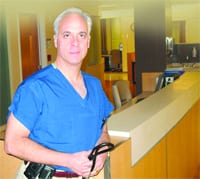Form and FunctionMercy’s New ICU Provides a Healing Environment
Dr. George Karras says that medical care is more about people than buildings. But ideally, hospitals need high quality from both.
Karras, the medical director of Critical Care and Respiratory Care at Mercy Medical Center, told The Healthcare News that the Springfield hospital’s newly opened intensive care unit provides exemplary care in cutting-edge surroundings.
“Ultimately, the care provided in an ICU is based on the nurses, the respiratory therapists, and the physicians, and on that basis our ICU has always been excellent,” Karras said. “What this new facility provides is an environment that we think is conducive to healing.”
Gone, at Mercy, are concerns about crowded quarters, lack of privacy, and sleep deprivation that affect many outmoded ICUs across the country today. The Mary E. Davis Intensive Care Unit, part one of a $16 million, two-phase overhaul of Mercy’s ICU and surgical facilities, has patients resting easier.
“Certainly, compared to this, our old ICU, which was built in the mid-’70s, was not functional for current-day patients,” Karras said. “There were a lot of problems in terms of traffic, privacy, and infection control, so clearly we need a new, state-of-the-art facility to go along with the excellent care we provide here.”
This month, The Healthcare News takes a look into Mercy’s latest achievement, and why the changes matter to patients and staff alike.
Here Comes the Sun
Touring the new ICU, the first impression is the copious amount of natural light streaming from large windows in the patient rooms and conference areas. Then there’s the color scheme, dominated by muted earth tones. Neither design choice was random, and both are based on more than aesthetics.
“We designed it to allow as much light as possible into each patient room. And the color schemes were chosen to have a calming, more healing effect,” Karras said. That amount of light and the color tones will help patients achieve better rest throughout the day, he added — “and sleep deprivation is a problem in ICUs across the county, and has been for many years.”
“I think that’s the biggest difference — the natural light and how the space is used,” said Joan Erwin, nurse manager of the ICU.
“Not only will this promote better sleep, but it will help reduce ICU delirium and psychosis,” Karras added, further explaining that crowding, traffic, and lack of privacy can make an already-ill patient confused and agitated, which can contribute to higher morbidity and mortality rates. “This environment will improve the overall outcome.”
Going hand-in-hand with that is the issue of privacy, which has become a major concern for hospitals in the era of the Health Insurance Portability and Accountability Act (HIPAA). Mercy’s old ICU had a number of patient rooms that were wide-open to the rest of the unit. The new unit boasts all single rooms, each of them 280 square feet in size, set back from the ICU’s main foot traffic but with clear sight lines to the nurses’ stations.
Come Together
Karras said plenty of medical research and anecdotal evidence supports the idea of a healing environment contributing to better patient outcomes. But in making its design decisions, the hospital leadership and architects also turned to the people who will spend the most time in the ICU — the employees who work there.
“All the elements that contribute to this ICU were decided in conjunction with the architects and the staff that works here,” Karras said. “We felt it was important that anyone who has anything to do with the ICU, from nurses and respiratory therapists to physical therapists, secretaries, and maintenance people, should have input into what’s happening.”
“We wanted them to have a say in what the place would look like and how it would function,” Erwin said.
The hospital strived to create an environment that’s pleasant for the people who work there, Karras added, “which would in turn reduce the prospect of burnout. They helped us with the layout and helped choose the types of paneling and floors.”
That environment has been enhanced by plenty of advanced technology, including state-of-the-art monitors and ventilators, and an all-wireless setup. “This new space allows for the use of these things, as well as effectively controlling traffic better,” Karras said. “We have more room to work and more storage space.” By doubling the size of the old ICU, he noted, Mercy was able to increase the total number of beds while allowing more space for each patient.
“We initially had a 12-bed ICU,” he said, “and we’ve found that, with the kinds of patients coming into Mercy and the number of beds in the Valley, which has shrunk over the past 20 years, it made more sense to have a 16-bed unit.” The unit actually sees typical intensive-care patients along with those with acute coronary diseases, and the nurses have been cross-trained to treat both.
Getting Better
That’s just the first step, however. The new ambulatory surgery unit, which will occupy the level above the ICU, will feature an all-new post-acute care unit and a pre-op suite that is entirely separate from the recovery suite, another way the new facilities stress patient privacy. Also in the plans are new, private recovery rooms and the modification of walls to improve visibility between patients and staff.
“That area will feel much like this ICU, with a similar color scheme and the same kind of approach to the environment, and improved flow in and out of the operating room,” Karras said.
That smoother flow, coupled with the additional ICU beds, is about much more than convenience. According to the U.S. Government Accountability Office, the number-one reason for emergency department overcrowding is ICU overcrowding, which leads to boarding of intensive-care patients in ERs.
“ED boarding of critically ill patients is becoming a common and especially challenging phenomenon, but few studies have addressed the effects of delayed ICU transfer on outcomes in such patients,” wrote Dr. Tiffany Osborn, an assistant professor of Emergency Medicine at the University of Virginia, in Journal Watch Emergency Medicine.
“The time has come for overcrowding to be acknowledged and managed as a hospital-wide problem with real consequences in terms of bad outcomes for patients,” she asserted. “As minutes … are squandered in inefficiency, the cost is human lives.”
Karras believes the improvements are Mercy are a significant step in the right direction. “This is certainly one of the newest ICUs in the country,” he said, “and I would venture to say that it’s clearly the most advanced ICU in the region.”
At a time when medical facilities become outdated at an alarming rate, how long the unit remains cutting-edge might be the ultimate test. For now, though, hospital officials are breathing a little easier — and so, hopefully, are patients.


